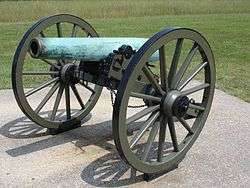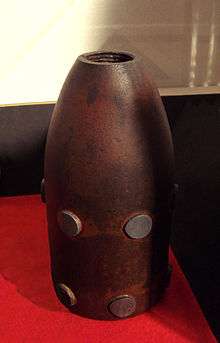Canon obusier de 12
| "Canon de l’Empereur" Canon obusier de campagne de 12 12-pounder "Napoleon" | |
|---|---|
|
Canon obusier de campagne de 12 modèle 1853 on display in Les Invalides. | |
| Type | Regimental artillery field gun |
| Place of origin |
|
| Service history | |
| Used by | France, United States, Confederate States of America |
| Wars | Crimean War, American Civil War |
| Production history | |
| Designed | 1853 |
| Number built |
France: ? United States: Union States: 1,100, Confederate states: 600 |
| Specifications | |
| Weight | 626 kg (1,227 lb), with carriage: 1,200 kg (2,353 lb) |
| Length | 1.91 m (66 in) |
| Crew | 4 |
|
| |
| Shell | 4.1 kg shell, ball, canister |
| Caliber | 121 mm (4.62 in) |
| Muzzle velocity | 439 m/s (1,440 ft/s) |
| Effective firing range | 1,480 m at 5° elevation (1,440 yd) |
The Canon obusier de 12 (French:"Canon obusier de campagne de 12 livres, modèle 1853", USA: 12-pounder Napoleon), also known as the "Canon de l’Empereur" was a type of canon-obusier (literally "Shell-gun cannon", "gun-howitzer") developed by France in 1853. Its performance and versatility (it was able to fire either ball, shell, canister or grapeshot) allowed it to replace all the previous field guns, especially the Canon de 8 and the Canon de 12 as well as the two howitzers of the Valée system.
The cannon owes its alias to French president and emperor Napoleon III.
Characteristics

The "canon obusier" was a smoothbore cannon firing either shells, balls, or canister. This was an improvement over previous cannon firing only balls, such as those of the Gribeauval system. Although the "canon obusier de 12 livres" is commonly described as a "12-pounder" in English, the "12" in the cannon's designation actually represented the caliber - the bore is the size of a solid cast-iron ball weighing 12 livres (old French pounds, about 1.079 English pounds), though the shot actually used might be of a different weight. The new weapon "revolutionized field artillery. The Napoleon was light enough to be moved rapidly on the battlefield by horses, heavy enough to destroy field fortifications almost a mile away, and versatile enough to fire solid shot, shell, spherical case, and canister."[1] The French Army introduced the "canon obusier de 12" in 1853.
American career
This type of "canon obusier", commonly called in English the "12-pounder Napoleon Model 1857", was the primary cannon used in the American Civil War.[2][3] Over 1,100 such Napoleons were manufactured by the North, and 600 by the South.[4] At Gettysburg, 142 out of 360 Federal guns (36%) were Napoleons.
The "12-pounder Napoleon" was widely admired because of its safety, reliability, and killing power, especially at close range. It was the last cast bronze gun used by an American army. The Federal version of the Napoleon can be recognized by the flared front end of the barrel, called the muzzle swell. Confederate Napoleons were produced in at least six variations, most of which had straight muzzles, but at least eight cataloged survivors of 133 identified have muzzle swells.

M1857 12-Pounder "Napoleon" 
M1857 12-Pounder "Napoleon" 
Confederate 12-Pound "Napoleon" 12-pound "Napoleon" USA-made in 1864
Succession

The smoothbore "canon obusier" was soon superseded by rifled cannons, which had much more accuracy and range, with the developments of Antoine Treuille de Beaulieu and the introduction of the La Hitte system in 1858.[6]
Napoleon III had his existing guns, such as the Canon obusier de 12, rifled to accommodate the La Hitte system. Such guns remained in use until 1870.[7]
See also
![]() Media related to Canon obusier de 12 at Wikimedia Commons
Media related to Canon obusier de 12 at Wikimedia Commons
- French weapons in the American Civil War
- Field artillery in the American Civil War
- licorne
- Twelve-pound cannon
Notes
- ↑ "The Napoleon". National Park Service. Archived from the original on December 7, 2008.
- ↑ The Mitrailleuse by Dr. Patrick Marder Military History Online
- ↑ Nps.gov
- ↑ Nps.gov
- ↑ Notice at the Ryozen Museum of History, Kyoto, Japan
- ↑ "...the introduction by the French army of the Beaulieu 4-pounder rifled field-gun in 1858: the new artillery, though much more accurate and long-ranged than the smoothbore 'canon-obusier' it replaced (which, incidentally, was the most prevalent artillery piece of the US Civil War), was not suited to firing anti-personnel case-shot (which, in French, is called 'mitraille')." in The Mitrailleuse by Dr. Patrick Marder Military History Online
- ↑ "Napoleon went so far, however, in 1858, as to order his SB guns rifled, under the bastard system known as the "Lahitte System," which continued in general use in France until 1870" in The Long Arm of Lee by Jennings Cropper Wise, Gary W. Gallagher p.30

